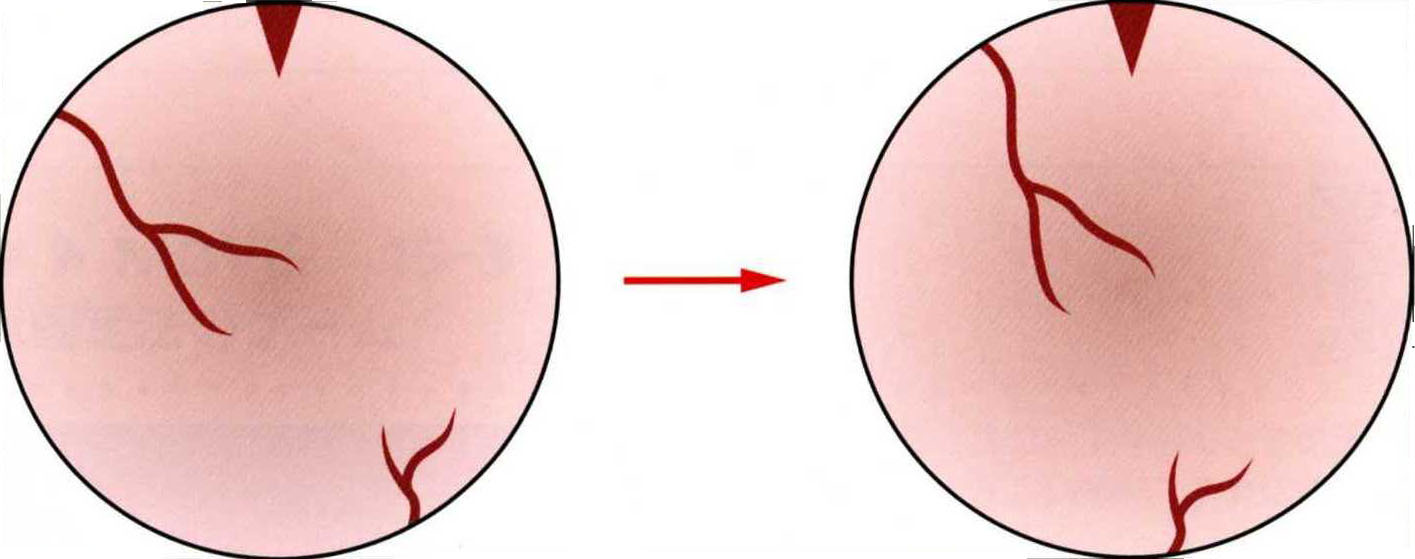|
15. |
2 LOOP JUDGMENT METHODS-THE BLIND METHOD AND THE FIXED-POINT METHOD |
TWO LOOP JUDMENT
METHODS
Basically, there are only two kinds of loops; the alpha loop which can be released with the clockwise rotation or the reversed-alpha loop which can be released with the counterclockwise rotation (refer p52). In the sigmoid colon, the former part of the colon, 80% of the loops formed are the alpha loops and 20% are the reversed-alpha loops, whereas in the transverse colon, the latter part of the colon, loops are 100% the reversed-alpha. Given these facts, it is possible to assume which loop is formed depending on where the scope is, however, for more precise assumption the loop judgment is applied.
There are two ways for judgment: the fixed-point method, in which the vision on the monitor is used, and the blind method, which uses the right's hand's sense.
|
[POINT] TWO WAYS FOR LOOP JUDGMENT 1) The blind method: judge with the right hand's sense |
The loop judgments are both applied when the circular loop is minimized. The fixed-point method is usually used, but when the view is not good enough due to the poor preparation, the blind method is chosen (Chart 15-1).
CHART 15-1 FLOW CHART OF LOOP JUDGMENT
LOOP JUDGMENT WITH THE BLIND
METHOD
Withdraw the scope to the minimized circle and stop when the scope feels heavy where the circular loop is almost minimized. Then twist the scope about 30 degrees in both directions. The direction in which the scope feels lighter is the right direction to release the loop, so twist the scope 90 degrees in that direction and withdraw and twist 90 more degrees simultaneously. This is called the blind method. It is mainly used when the fixed-point method is not readily available due to poor preparation and the like.
LOOP JUDMENT WITH THE FIXED-POINT
METHOD
You can tell when the circular loop is minimized from heaviness sensed with the right hand. As the fiberscope is withdrawn a little the view on the monitor will turn around a little. That turning direction is the right direction to release the loop. You can practice with the scope on a bed.

CHART 15-2 LOOP JUDGMENT WITH THE BLIND METHOD Withdrawing the scope only a little after the minimized circular loop, the scope itself would turn in one direction. Twist the scope in that direction. |

CHART 15-3 LOOP JUDMENT WITH THE FIXED-POINT METHOD If the view of the membrane turns clockwise when the scope is withdrawn, twist the scope clockwise and the loop would be released. This case, for example, is an alpha-loop release. |
The fixed-point method can be used to release the twist of the colon before its forming a complete loop, therefore this method is frequently applied in the pull method where there is not supposed to be a loop. In short, if the scope is withdrawn and the view on the monitor moves, follow the movement in the same direction to keep the view fixed. Thereby, the intestine can be straightened without the scope's falling (Chart 15-4). This is the most useful technique in the colonoscopy insertion.
CHART 15-4 FLOWCHART OF LOOP JUDGMENT BY THE FIXED-POINT METHOD
|
MOVIE 15-1 TWO METHODS OF LOOP JUDGMENT There are two ways of loop judgment: the blind method with the sense of the right hand and the fixed-point method with the view on the monitor. |
|
MOVIE 15-2 THE FIXED-POINT METHOD Hook the scope tip on the fold going to left right after traversing the rectum and pull the scope slowly and carefully. If the lumen starts to turn clockwise then follow the movement and use the right turn of scope. When the fold moves to the right of the view, stop pulling the scope and traverse the fold with the right angulation. At this point the strong right angulation is required, so practice the right angulation. |
|
MOVIE 15-3 GAME OF THE FIXED-POINT METHOD Press start and the game will start. Choose the right maneuver when the fiber is withdrawn. If the choice is correct, the view will move. |